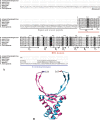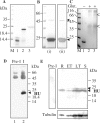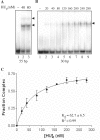DNA organization by the apicoplast-targeted bacterial histone-like protein of Plasmodium falciparum
- PMID: 18663012
- PMCID: PMC2528193
- DOI: 10.1093/nar/gkn483
DNA organization by the apicoplast-targeted bacterial histone-like protein of Plasmodium falciparum
Abstract
Apicomplexans, including the pathogens Plasmodium and Toxoplasma, carry a nonphotosynthetic plastid of secondary endosymbiotic origin called the apicoplast. The P. falciparum apicoplast contains a 35 kb, circular DNA genome with limited coding capacity that lacks genes encoding proteins for DNA organization and replication. We report identification of a nuclear-encoded bacterial histone-like protein (PfHU) involved in DNA compaction in the apicoplast. PfHU is associated with apicoplast DNA and is expressed throughout the parasite's intra-erythocytic cycle. The protein binds DNA in a sequence nonspecific manner with a minimum binding site length of approximately 27 bp and a K(d) of approximately 63 nM and displays a preference for supercoiled DNA. PfHU is capable of condensing Escherichia coli nucleoids in vivo indicating its role in DNA compaction. The unique 42 aa C-terminal extension of PfHU influences its DNA condensation properties. In contrast to bacterial HUs that bend DNA, PfHU promotes concatenation of linear DNA and inhibits DNA circularization. Atomic Force Microscopic study of PfHU-DNA complexes shows protein concentration-dependent DNA stiffening, intermolecular bundling and formation of DNA bridges followed by assembly of condensed DNA networks. Our results provide the first functional characterization of an apicomplexan HU protein and provide additional evidence for red algal ancestry of the apicoplast.
Figures








Similar articles
-
The Plasmodium HU homolog, which binds the plastid DNA sequence-independent manner, is essential for the parasite's survival.FEBS Lett. 2009 May 6;583(9):1446-50. doi: 10.1016/j.febslet.2009.03.071. Epub 2009 Apr 7. FEBS Lett. 2009. PMID: 19358847
-
An unusual ERAD-like complex is targeted to the apicoplast of Plasmodium falciparum.Eukaryot Cell. 2009 Aug;8(8):1134-45. doi: 10.1128/EC.00083-09. Epub 2009 Jun 5. Eukaryot Cell. 2009. PMID: 19502583 Free PMC article.
-
Apicoplast genome of the coccidian Eimeria tenella.Gene. 2003 Dec 4;321:39-46. doi: 10.1016/j.gene.2003.08.008. Gene. 2003. PMID: 14636990
-
Replication and maintenance of the Plasmodium falciparum apicoplast genome.Mol Biochem Parasitol. 2016 Aug;208(2):56-64. doi: 10.1016/j.molbiopara.2016.06.006. Epub 2016 Jun 20. Mol Biochem Parasitol. 2016. PMID: 27338018 Review.
-
The apicoplast: a plastid in Plasmodium falciparum and other Apicomplexan parasites.Int Rev Cytol. 2003;224:57-110. doi: 10.1016/s0074-7696(05)24003-2. Int Rev Cytol. 2003. PMID: 12722949 Review.
Cited by
-
Nucleosome landscape and control of transcription in the human malaria parasite.Genome Res. 2010 Feb;20(2):228-38. doi: 10.1101/gr.101063.109. Epub 2010 Jan 6. Genome Res. 2010. PMID: 20054063 Free PMC article.
-
Initial characterization of the Pf-Int recombinase from the malaria parasite Plasmodium falciparum.PLoS One. 2012;7(10):e46507. doi: 10.1371/journal.pone.0046507. Epub 2012 Oct 8. PLoS One. 2012. PMID: 23056326 Free PMC article.
-
HBD1 protein with a tandem repeat of two HMG-box domains is a DNA clip to organize chloroplast nucleoids in Chlamydomonas reinhardtii.Proc Natl Acad Sci U S A. 2021 May 18;118(20):e2021053118. doi: 10.1073/pnas.2021053118. Proc Natl Acad Sci U S A. 2021. PMID: 33975946 Free PMC article.
-
The HU protein is important for apicoplast genome maintenance and inheritance in Toxoplasma gondii.Eukaryot Cell. 2012 Jul;11(7):905-15. doi: 10.1128/EC.00029-12. Epub 2012 May 18. Eukaryot Cell. 2012. PMID: 22611021 Free PMC article.
-
A Plasmodium apicoplast-targeted unique exonuclease/FEN exhibits interspecies functional differences attributable to an insertion that alters DNA-binding.Nucleic Acids Res. 2024 Jul 22;52(13):7843-7862. doi: 10.1093/nar/gkae512. Nucleic Acids Res. 2024. PMID: 38888125 Free PMC article.
References
-
- Wilson RJM. Progress with parasite plastids. J. Mol. Biol. 2002;319:257–274. (Iain) - PubMed
-
- Foth BJ, McFadden GI. The apicoplast: a plastid in Plasmodium falciparum and other apicomplexan parasites. Int. Rev. Cytol. 2003;224:57–110. - PubMed
-
- Wilson RJM. Parasite plastids: approaching the endgame. Biol. Rev. 2005;80:129–153. (Iain) - PubMed
-
- Fichera ME, Roos DS. A plastid organelle as a drug target in apicomplexan parasites. Nature. 1997;390:407–409. - PubMed
-
- Gardner MJ, Williamson DH, Wilson RJM. A circular DNA molecule in malaria parasites encodes an RNA polymerase like that of prokaryotes and chloroplasts. Mol. Biochem. Parasitol. 1991;44:115–124. - PubMed
Publication types
MeSH terms
Substances
LinkOut - more resources
Full Text Sources
Molecular Biology Databases

